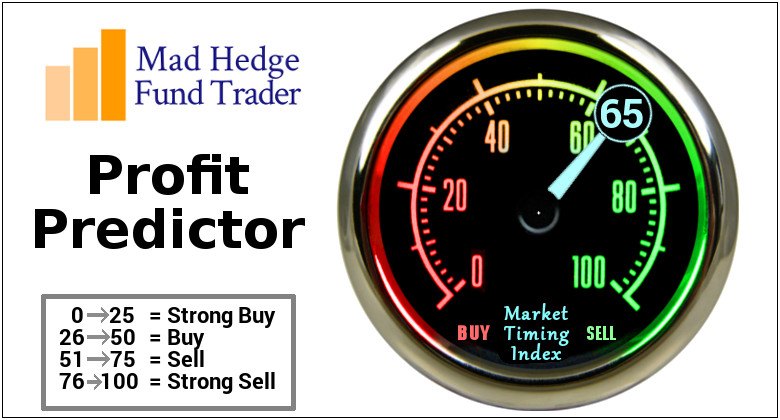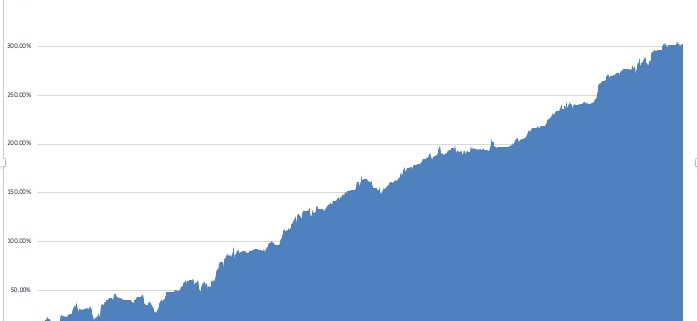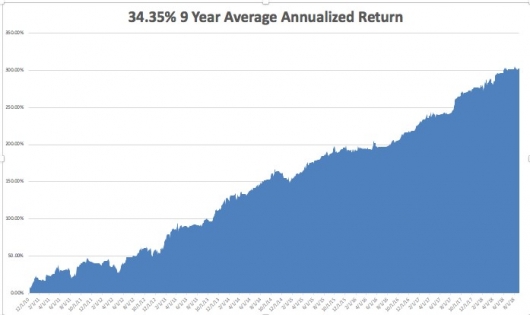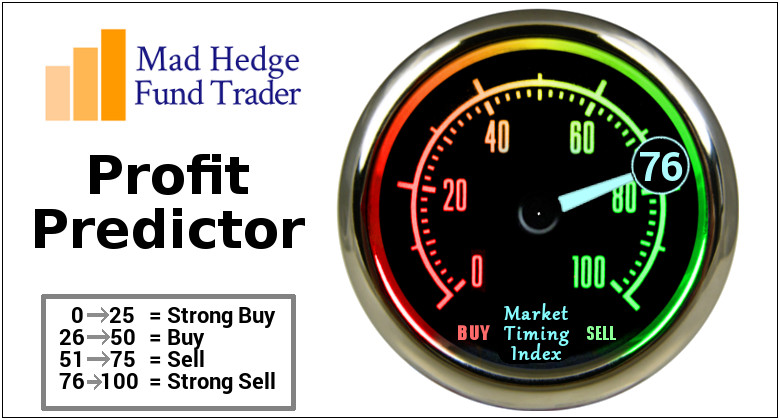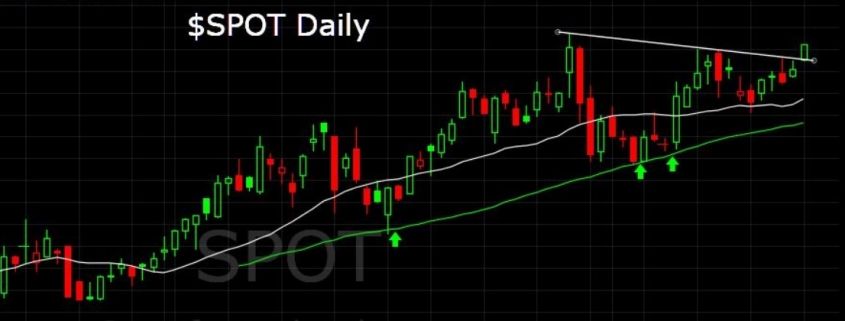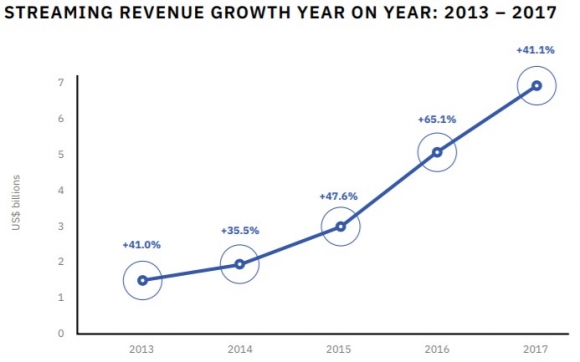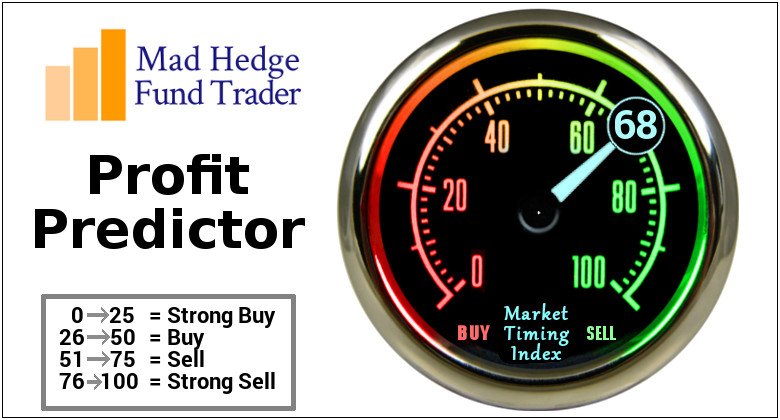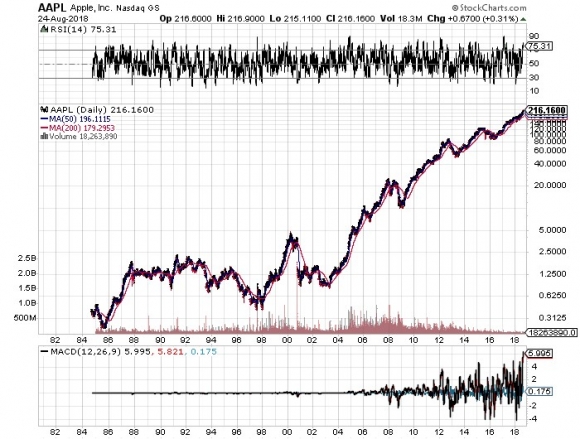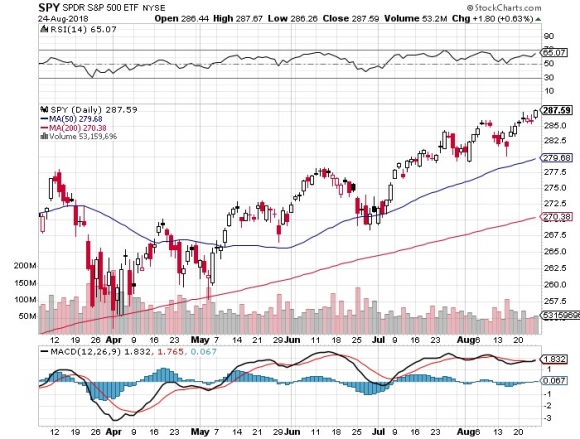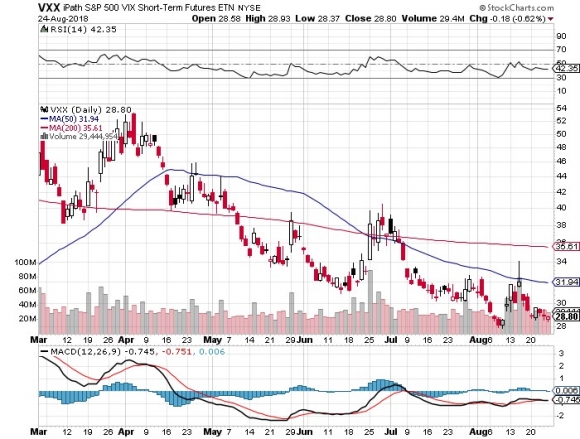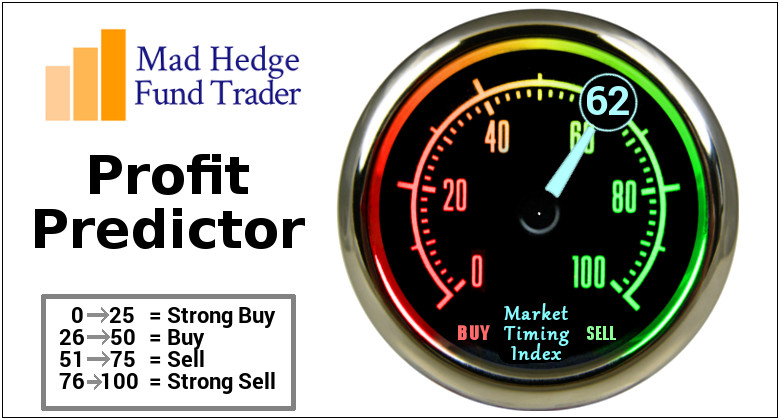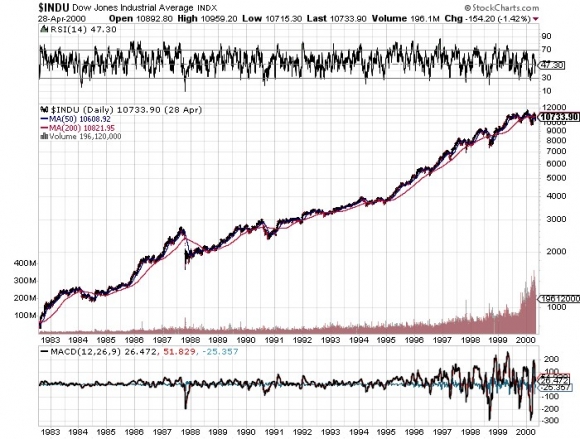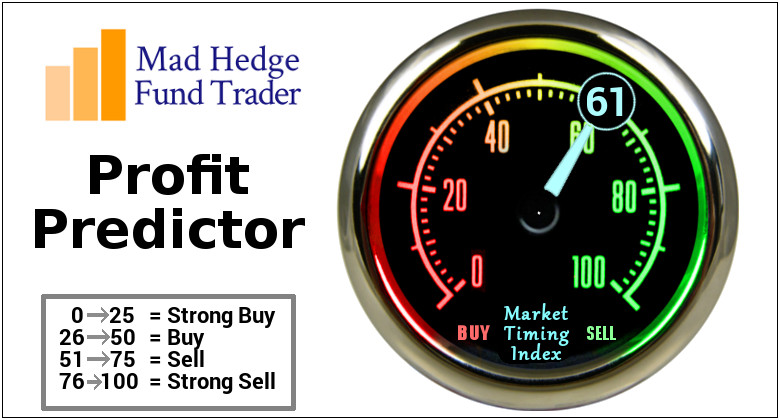Global Market Comments
September 4, 2018
Fiat Lux
Featured Trade:
(WEDNESDAY, OCTOBER 17, 2018, HOUSTON GLOBAL STRATEGY LUNCHEON),
(DON’T MISS THE SEPTEMBER 5 GLOBAL STRATEGY WEBINAR),
(THE MARKET OUTLOOK FOR THE WEEK AHEAD, or
THE WAR WITH CANADA STARTS ON TUESDAY),
(MSFT), (VXX), (TLT), (AAPL), (KO), (GM), (F)
Tag Archive for: (AAPL)
I have spent all weekend sitting by the phone, waiting for the call from Washington D.C. to re-activate my status as a Marine combat pilot.
Failure of the administration to reach a new NAFTA trade agreement by the Friday deadline makes such a conflict with Canada inevitable.
And while you may laugh at the prospect of an invasion from the North, the last time this happened Washington burned. You can still see the black scorch marks inside the White House today.
This is all a replay for me, when in 1991, I enjoyed an all-expenses paid vacation courtesy of Uncle Sam. That’s when I spent a year shuttling American fighter pilots from RAF Lakenheath to forward bases at Ramstein, Aviano, Cyprus, and Dharan, Saudi Arabia.
It may seem unlikely that our nation’s military would require the services of a decrepit 66-year-old. However, in my last conflict I ran into another draftee who was then 66. It seems that the Air Force then had a lot of F-111 fighter bombers left over from Vietnam that no one knew how to fly.
That’s the great thing about the military. It never throws anything away. Not even me. The life of our remaining B-52 Stratofortress bombers at their final retirement in 2050 will be 100 years.
Perhaps Canada will decide that discretion is the better part of valor, and simply wait for the World Trade Organization to declare the Trump tariffs illegal, which they obviously all are.
That would then force the administration to withdraw from the organization the U.S. created at the end of WWII to regulate fair trade and go rogue. But then what else is new?
And while there was immense media time devoted to the NAFTA talks, which only oversees trade with partners with around $2 trillion each, China, the 800-pound gorilla, is still lurking out there. It has a $12.2 trillion GDP and Trump is imposing tariffs on another $200 billion of their imports there today.
The corner that Trump has painted himself into is that he has made himself SO unpopular abroad, insulting virtually everyone but Russia, that no leader is willing to risk doing a deal with him lest they get kicked out of office.
I certainly felt this in Europe this summer where the discussion was all about Trump all of the time. When you insult a nation’s leader you insult everyone in that country. I haven’t received that kind of treatment since the Vietnam War was running hot and heavy in 1968.
I’ll tell you, I’d much rather be flying combat missions over enemy territory without a parachute than trading a market like we had last week. For months now, it has been utterly devoid of low risk/high return entry points for all asset classes.
It’s been a slow-motion melt-up virtually every day against the most horrific news backdrop imaginable. Such is the wonder of massive global excess liquidity. It Trumps everything.
NASDAQ topped 8,000, proving that if you aren’t loaded to the gills with technology stocks, as I have been pleading all year, you are out of your freaking mind. If you don’t own Apple, you are doubly screwed.
I doubt that such data is available, but I bet the illiterate and the uneducated have been beating more literate types in performance by a huge margin.
The unresponsiveness to news isn’t the only thing afflicting this market. As the summer coughs and sputters its way to a close, we enter September, notorious as the most horrific trading month of the year. And we are launching into it with the Mad Hedge Market Timing Index stuck in the 70s, overbought territory, for weeks now.
Blockbuster earnings, the principal impetus for rising share prices in 2018, are now firmly in the rearview mirror, and won’t make a reappearance for another month. Then they die completely in 2019.
Perhaps this is why my long volatility position in the (VXX) is doing moderately well, even though the indexes have been hitting new all-time highs, with the S&P 500 briefing kissing $292. I rather practice my golf swing rather than try to outtrade this market, even though I don’t play golf.
Other than NAFTA, there was little to trade off of last week. Apple (AAPL) shares continue to break new records, hitting an incredible $228, in front of their big iPhone launch this month. Trump announced he was freezing wages on 1 million-plus federal employees next year. That will solve their tax problems for sure.
Coca-Cola (KO) bought British owned Costa for $5 billion, where I regularly breakfast while traveling abroad, in the hopes that perhaps its 501st new drink launch this year will be successful.
Amazon (AMZN) is within sofa change of becoming the next $1 trillion market cap company, making the parents of founder Jeff Bezos the most successful angel investors in history, worth $30 billion.
U.S. auto sales are in free fall. Car company shares (GM), (F) continued their slide as they are pummeled on every side by administration economic policies. One has to ask the question of how long the American economy can survive after losing a major leg like this one. Home sales, another vital component, are also suddenly awful.
Trump attacked big tech. The market yawned.
With the Mad Hedge Market Timing Index at 71 and bounces around in the 70s all week, I am not inclined to reach for trades here. All three of my current positions are making money, my longs in Microsoft (MSFT) and volatility (VXX) and my short in the U.S. Treasury bond market (TLT).
August finally brought in a performance burst in the final days, leaving us with a respectable return of 2.13%. My 2018 year-to-date performance has clawed its way back up to 25.30% and my nine-year return appreciated to 303.48%. The Averaged Annualized Return stands at 34.35%. The more narrowly focused Mad Hedge Technology Fund Trade Alert performance is annualizing now at an impressive 28.59%.
This coming week housing statistics will give the most important insights on the state of the economy.
On Monday, September 3, there was a national holiday, Labor Day.
On Tuesday, September 4, at 9:45 AM the PMI Manufacturers Index is out. August Construction Spending is out at 10:00 AM.
On Wednesday, September 5 at 7:00 AM, we learn MBA Mortgage Applications for the previous week.
Thursday, September 6 leads with the Weekly Jobless Claims at 8:30 AM EST, which saw a rise of 3,000 last week to 213,000. Also announced at 9:45 AM are the August PMI Services Index.
On Friday, September 7 the Baker Hughes Rig Count is announced at 1:00 PM EST.
As for me, the high point of my weekend was the funeral services for Senator John McCain. Boy, the Squids really know how to put on a ceremony. I suspect it may market a turning point for our broken American politics.
In the meantime, King Canute sits in his throne at the seashore ordering the tide not to rise.
Good luck and good trading.
Mad Hedge Technology Letter
August 28, 2018
Fiat Lux
Featured Trade:
(SPOTIFY STILL HAS SOME UPSIDE),
(SPOT), (AMZN), (AAPL), (P)
Investors sulking about Spotify’s (SPOT) inability to make money do not get the point.
Yes, the job of every company to be in the black, but the No. 1 responsibility for a modern tech company is to grow, and grow fast.
Tech investors pay for growth, period.
As investors have seen from Netflix, companies can always raise prices after seizing market share because of the stranglehold on eyeballs inside a walled garden.
That potent formula has been the bread and butter of powerful tech companies of late.
Spotify is a captive of the music industry, of which it is entirely dependent for its source of goods, in this case songs.
At the same time, the music industry has fought tooth and nail to destroy the likes of Spotify, which benefits immensely from distributing the content it creates.
History is littered with failed music streaming services outgunned in the courtroom. Pandora (P) is the biggest public name out there whose share price has tanked over the long haul.
The music industry will battle relentlessly to exterminate Spotify and force up the royalties these Internet giants must pay as their main input.
But that does not mean Spotify is a bad company or even a bad stock.
Every company has its share of pitfalls. Throw in the mix that Amazon (AMZN) and Apple (AAPL) have music streaming services that do not even need to make a profit, and you will understand why some might be wary about putting new money to work in music streaming business stocks.
The primary reason that Spotify shares will outperform for the foreseeable future is because it is the preeminent music streaming platform.
Also, there is favorable latitude to make way toward the goal of monetization, and ample space to improve gross margins.
Global streaming revenue growth has gone ballistic as the migration to mobile and cord cutting has exacerbated the monetization prospects of the music industry.
Streaming revenue was a shade under $2 billion in 2013, and continued to post a growth trajectory of more than 40% each year since.
As it stands now, total global streaming revenue registered just a tick under $7 billion per year in 2017, and that was an improvement of 41.1% from 2016.
There are no signs of yielding as more avid music fans push into the music streaming space.
Social media platforms have helped publicize popular artists’ content.
Music is effectively a strong part of youth culture, which will eventually see the youth integrate a music streaming app into their daily lives for the rest of their adult lives.
The choice among choices is Spotify in 2018.
The company was dogged by many years of famous artists removing their proprietary content from the platform citing unfavorable terms.
A prime example was in 2009 when Lady Gaga’s hit song “Poker Face” only received $167 in royalty payments from Spotify for the first million streams. This highlighted the rock-solid position Spotify has curated inside the music industry.
Individual artists’ fight against Spotify has been dead on arrival from the outset, but the benefits and exposure from cooperating with the company far outweigh the drawbacks.
Eventually, almost all artists have relented and reinstalled their music on Spotify. They depend on alternative moneymaking avenues to compensate for lack of royalties, which is mainly live music.
That is why it costs an arm and a leg to go see Taylor Swift in living flesh now, and why those summer festivals dotted around America such as Coachella command premium ticket prices.
How does Spotify make money?
It earns its crust of bread through paid subscriptions but lures in eyeballs using an ad-supported free version of its platform.
Naturally, the paid version is ad-less, and this subscription is around $5 to $15 per month.
In the second quarter, Spotify’s paid subscription volume surpassed 83 million, a sharp uptick of 40% YOY.
Ad-supported users came in at more than 101 million, even under the damage that General Data Protection Regulation (GDPR) did to western tech companies.
The ad-supported subscribers rose 23% YOY, and the paid version expects between 85 million to 88 million paid subscribers in the third quarter.
Many of the new paid subscribers are converts from its free model.
Spotify is poised to increase revenue between 20%-30% for the rest of the year.
The rise of Spotify's developing data division could extract an additional $580 million of revenue in 2023, making up 2% of total revenue.
Remember that Spotify’s reference price set by the New York Stock Exchange (NYSE) was $132 in April 2018. The parabolic move in the stock on the verge of eclipsing $200 undergirds the demand for high-quality tech companies.
When Spotify did go public, the robust price action was with conviction, making major investors - such as China’s Tencent, which possess a 9.1% stake and Tiger Global Management, which owns 7.2% - happy stakeholders.
In the last quarter’s earnings report, Spotify CFO Barry McCarthy reiterated the company’s goal to push gross margins from the mid-20% range to “gross margins in the 30% to 35% range.”
A jump in gross margins would go a long way in making Spotify appear more profitable, and that is the imminent goal right now.
The path to real profitability is still a long way down the road and small victories will offer short-term strength to the share price.
If Spotify can retrace to around the $185, that would serve as a perfect entry point into a stock that has given investors few chances in which to participate.
July and August have only offered meager entry points into this stock, one around the $180 level in August, and another around $170 in July.
Spotify enjoyed a great first day of being public after its unorthodox IPO ending the day at $149. The momentum has continued unabated while Spotify has posted all the growth targets investors come to expect from companies of this ilk.
Bask in the glow of the growth sweet spot Spotify finds itself in right now.
The long-term narrative of this stock is intact for a joyous ride upward, and only whispers of Amazon and Apple meaningfully attempting to monetize this segment could derail it.
For the time being, the music part of Amazon and Apple are just a side business. They have other priorities, such as Apple’s battle to avoid being exterminated from communist China, and Amazon’s integration of Whole Foods and new-fangled digital ad business.
The Dominant Music Streaming Platform of 2018
________________________________________________________________________________________________
Quote of the Day
“Ever since Napster, I’ve dreamt of building a product similar to Spotify,” – said cofounder and CEO of Spotify Daniel Ek.
Global Market Comments
August 27, 2018
Fiat Lux
Featured Trade:
(THE MARKET OUTLOOK FOR THE WEEK AHEAD),
(AAPL), (TLT), (SPY),
(BIDDING MORE FOR THE STARS),
(SPY), (INDU), (AAPL), (AMZN)
Ahhhh…the wonders of global excess liquidity.
Last week saw senior-level felony convictions, the real estate and auto industries rolling over and playing dead, rising inflation, escalating trade wars, sagging exports. It’s as if an entire flock of black swans landed on the markets.
And what did stocks do? Rocket to new all-time highs, Of course! What, are you, some kind of dummy? Didn’t you get the memo? With $50 trillion of global excess liquidity spawned by a decade of quantitative easing, of course stocks will go straight up, forever!
Until they don’t.
Even my favorite, Apple (AAPL) blasted through to new highs at $219 after an analyst raised his target to $245. You may recall me loading the boat with Apple calls during the February meltdown when the shares hit $150.
My target for Apple this year was $200, which I then raised to $220. Am I going to raise my target again? No. As my late mentor, Barton Biggs used to say, “Always leave the last 10% for the next guy.”
It kind of makes my own split adjusted cost of Apple shares of 50 cents, which I picked up in 1998, look pretty good. Yup. That double bottom on the charts at 40 cents said it all.
I used the strength to increase my cash position from 80% to 90%, unloading my long position in Walt Disney options at cost. That leaves me with a single short position in bonds (TLT), which have to see yield on the 10-year U.S. Treasury bond market to fall below 2.67% in three weeks before I lose money.
I am even focusing a sharp eye on the Volatility Index (VIX) for a trade alert this week. If you buy the January 2019 (VXX) $40 calls at $2.90 and the ETF rises 25 points to its April high of $54, these calls would rocket by 382% to $14.00. Sounds like a trade to me! Then I can say thank you very much to Mr. Market, thumb my nose at him, and then take off for the rest of the year. TA-TA!
In the meantime, much of industrial America is getting ready to shut down. Tariffs on 50% of all Chinese imports come into force in September. It turns out that you can’t make anything in the U.S. without the millions of little Chinese parts you’ve never heard of, which also have no U.S. equivalent.
Factories will have to either pass their costs on to consumers in a deflationary economy or shut down. What the administration has done is offset a tax cut with a tax increase in the form of higher import taxes. It was not supposed to work out like that.
The bond rally has pared back my August performance to a dead even at 0.02%. My 2018 year-to-date performance has pulled back to 24.84% and my nine-year return appreciated to 301.31%. The Averaged Annualized Return stands at 34.76%. The more narrowly focused Mad Hedge Technology Fund Trade Alert performance is annualizing now at an impressive 32.24%.
This coming week will be real estate dominated on the data front.
On Monday, August 27, at 10:30 AM EST, we obtain the Dallas Fed Manufacturing Survey.
On Tuesday, August 28, at 9:00 AM EST, we get the June S&P CoreLogic Case-Shiller National Home Price Index. Will we start to see the price falls that more current data are already showing?
On Wednesday, August 29, at 10:00 AM EST, we learn July Pending Home Sales, which lately have been weak.
Thursday, August 30, leads with the Weekly Jobless Claims at 8:30 AM EST, which saw a fall of 2,000 last week to 210,000.
On Friday, August 31, at 10:00 AM EST, we get Chicago Purchasing Managers Index for July. Then the Baker Hughes Rig Count is announced at 1:00 PM EST.
As for me, I think I’ll pop over to the Pebble Beach Concours d'Elegance vintage car show this weekend and place a bid on Ferris Bueller’s red 1962 Ferrari GT California. It’s actually a Hollywood custom chassis built around a Ford engine. I can’t afford a real vintage Ferrari GTO, one of which is expected to sell for an eye-popping $60 million this weekend.
Good luck and good trading.
The stock market has turned into the real estate market, where everyone is afraid to sell their shares for fear of being unable to find a replacement. Will it next turn into the Bitcoin market?
Risk assets everywhere are now facing a good news glut.
My 2019 market top target of 28,000 for the Dow Average is rushing forward with reckless abandon.
Today's price action really gives you the feeling of an approaching short-term blow-off market top.
A few years ago, I went to a charity fundraiser at San Francisco's priciest jewelry store, Shreve & Co., where the well-heeled men bid for dates with the local high society beauties, dripping in diamonds and Channel No. 5.
Amply fueled with champagne, I jumped into a spirited bidding war over one of the Bay Area's premier hotties, whom shall remain nameless. Suffice to say, she is now married to a tech titan and has a sports stadium named after her.
Obviously, I didn't work hard enough.
The bids soared to $23,000, $24,000, $25,000.
After all, it was for a good cause. But when it hit $26,000, I suddenly developed a severe case of lockjaw.
Later, the sheepish winner with a severe case of buyer’s remorse came to me and offered his date back to me for $24,000. I said, “No thanks.” He then implored, “$23,000, $22,000, $21,000?"
I passed.
The altitude of the stock market right now reminds me of that evening.
If you rode the S&P 500 (SPX) from 667 to 2,790 and the Dow Average (INDU) from 7,000 to 25,790, why sweat trying to eke out a few more basis points, especially when the risk/reward ratio sucks so badly, as it does now?
Here we are eight months into the year, and my top picks for the year have gone ballistic. Amazon (AMZN) has doubled off its February low of $1,000, and Apple (AAPL) shares have soared from $150 to $217. Today, an analyst raised his forecast to $245.
As my late mentor, Morgan Stanley’s Barton Biggs, always used to tell me, “Always leave the last 10% for the next guy.”
I realize that many of you are not hedge fund managers, and that running a prop desk, mutual fund, 401k, pension fund, or day trading account has its own demands.
But let me quote what my favorite Chinese general, Deng Xiaoping, once told me: "There is a time to fish, and a time to hang your nets out to dry.
You don't have to chase every trade.
At least then I'll have plenty of dry powder for when the window of opportunity reopens for business. So, while I'm mending my nets, I'll be building new lists of trades for you to strap on when the sun, moon, and stars align once again.
What Am I Bid?
Global Market Comments
August 23, 2018
Fiat Lux
Featured Trade:
(WHY THE DOW IS GOING TO 120,000),
(X), (IBM), (GM), (MSFT), (INTC), (DELL),
($INDU), (NFLX), (AMZN), (AAPL), (GOOGL),
(THE MAD HEDGE CONCIERGE SERVICE HAS AN OPENING),
(TESTIMONIAL)
For years, I have been predicting that a new Golden Age was setting up for America, a repeat of the Roaring Twenties. The response I received was that I was a permabull, a nut job, or a conman simply trying to sell more newsletters.
Now some strategists are finally starting to agree with me. They too are recognizing that a ganging up of three generations of investment preferences will combine to drive markets higher during the 2020s, much higher.
How high are we talking? How about a Dow Average of 120,000 by 2030, up another 465% from here? That is a 20-fold gain from the March 2009 bottom.
It’s all about demographics, which are creating an epic structural shortage of stocks. I’m talking about the 80 million Baby Boomers, 65 million from Generation X, and now 85 million Millennials. Add the three generations together and you end up with a staggering 230 million investors chasing stocks, the most in history, perhaps by a factor of two.
Oh, and by the way, the number of shares out there to buy is actually shrinking, thanks to a record $1 trillion in corporate stock buybacks.
I’m not talking pie in the sky stuff here. Such ballistic moves have happened many times in history. And I am not talking about the 17th century tulip bubble. They have happened in my lifetime. From August 1982 until April 2000 the Dow Average rose, you guessed it, exactly 20 times, from 600 to 12,000, when the Dotcom bubble popped.
What have the Millennials been buying? I know many, like my kids, their friends, and the many new Millennials who have recently been subscribing to the Diary of a Mad Hedge Fund Trader. Yes, it seems you can learn new tricks from an old dog. But they are a different kind of investor.
Like all of us, they buy companies they know, work for, and are comfortable with. During my Dad’s generation that meant loading your portfolio with U.S. Steel (X), IBM (IBM), and General Motors (GM).
For my generation that meant buying Microsoft (MSFT), Intel (INTC), and Dell Computer (DELL).
For Millennials that means focusing on Netflix (NFLX), Amazon (AMZN), Apple (AAPL), and Alphabet (GOOGL).
That’s why these four stocks account for some 40% of this year’s 7% gain. Oh yes, and they bought a few Bitcoin along the way too, to their eternal grief.
There is one catch to this hyper-bullish scenario. Somewhere on the way to the next market apex at Dow 120,000 in 2030 we need to squeeze in a recession. That is increasingly becoming a topic of market discussion.
The consensus now is that an impending inverted yield curve will force a recession sometime between August 2019 to August 2020. Throwing fat on the fire will be a one-time only tax break and deficit spending that burns out sometime in 2019. These will be a major factor in U.S. corporate earnings growth dramatically slowing down from 26% today to 5% next year.
Bear markets in stocks historically precede recessions by an average of seven months so that puts the next peak in top prices taking place between February 2019 to February 2020.
When I get a better read on precise dates and market levels, you’ll be the first to know.
To read my full research piece on the topic please click here to read “Get Ready for the Coming Golden Age.”
Dow 1982-2000 Up 20 Times in 18 Years
Dow 2009-Today Up 4.3 Times in 9 Years So Far
Mad Hedge Technology Letter
August 22, 2018
Fiat Lux
Featured Trade:
(WHAT’S IN STORE FOR TECH IN THE SECOND HALF OF 2018?),
(GOOGL), (AMZN), (FB), (UTX), (UBER), (LYFT), (MSFT), (MU), (NVDA), (AAPL), (SMH)
Legal Disclaimer
There is a very high degree of risk involved in trading. Past results are not indicative of future returns. MadHedgeFundTrader.com and all individuals affiliated with this site assume no responsibilities for your trading and investment results. The indicators, strategies, columns, articles and all other features are for educational purposes only and should not be construed as investment advice. Information for futures trading observations are obtained from sources believed to be reliable, but we do not warrant its completeness or accuracy, or warrant any results from the use of the information. Your use of the trading observations is entirely at your own risk and it is your sole responsibility to evaluate the accuracy, completeness and usefulness of the information. You must assess the risk of any trade with your broker and make your own independent decisions regarding any securities mentioned herein. Affiliates of MadHedgeFundTrader.com may have a position or effect transactions in the securities described herein (or options thereon) and/or otherwise employ trading strategies that may be consistent or inconsistent with the provided strategies.

